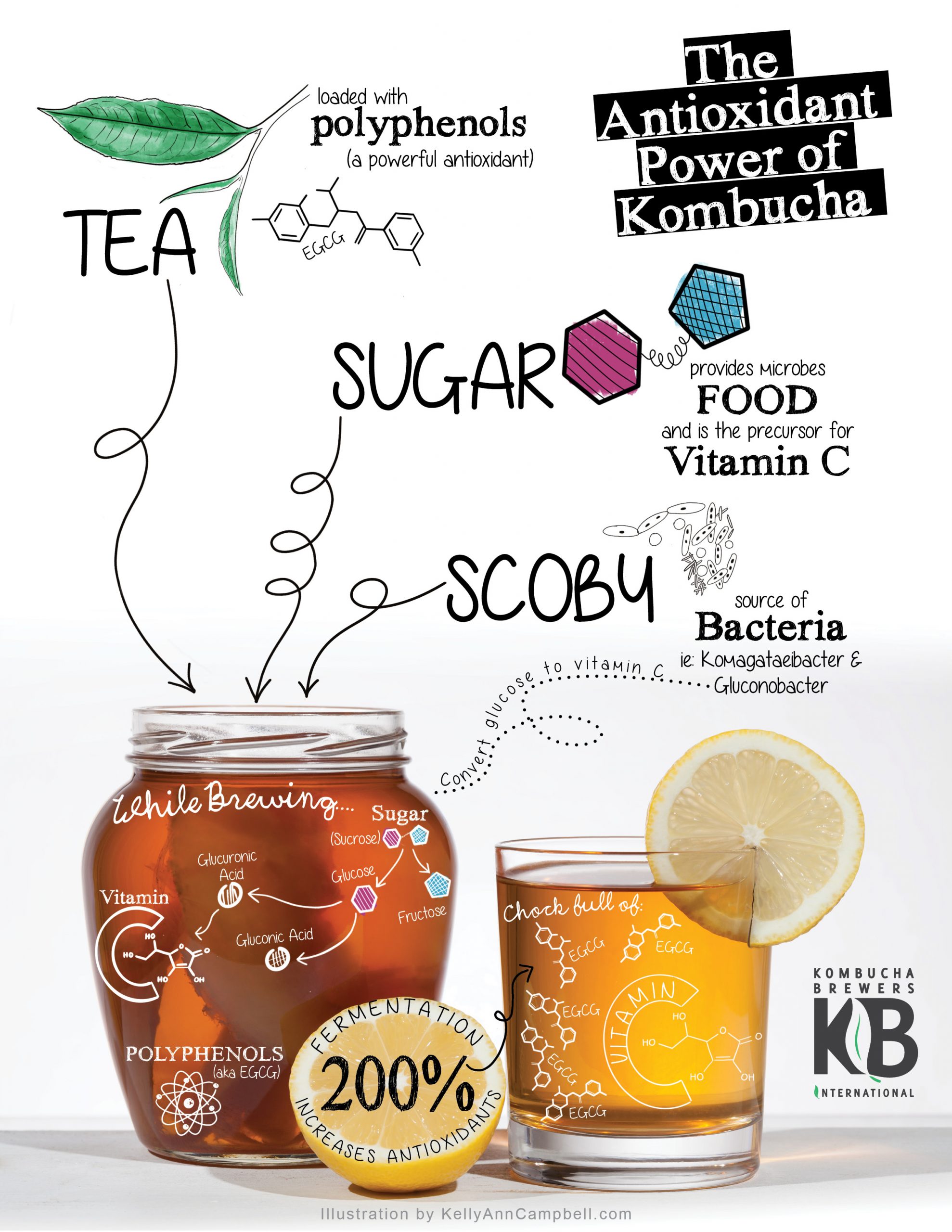What is Kombucha?
Kombucha, aka fermented sweet tea, is a delightful melange of tang and fizz praised by consumers for its broad flavor profile that spans from fruity to earthy to medicinal. The fermentation begins when the microorganisms from a mother SCOBY (Symbiotic Culture of Bacteria and Yeast) are added to a mixture of tea and sugar. Yeast and bacteria consume the nitrogen from the tea and carbon from the sugar to produce an easy drinking “tea vinegar”. The acetic bite, characteristic of Kombucha, mainly comes from Acetobacteraceae, the same family of bacteria responsible for giving apple cider vinegar, balsamic, and other vinegars their “vinegar-y” sour. However, unlike vinegar fermentation, the aerobic fermentation of Kombucha is shortened to make its flavor profile more complex and palatable. When oxygen exposure is halted during anaerobic fermentation, Lactobacillaceae may prosper and produce a “sharp” lactic acid. Several strains within this family of bacteria are associated with probiotic activity (3).
Kombucha is at the epicenter of the Venn diagram between the gut microbiome and functional foods. Increasingly popular as consumers seek minimally processed and nutritionally-dense options, its unique flavor profile and benefits are piquing both curiosity and taste buds. Fermented products, in general, have been accepted by the public and the scientific community as functional foods (1, 2). During the process of fermentation, microbes transform substrates within raw materials into metabolites with improved flavor and bioavailability. In the case of Kombucha, fermentation not only yields delicious flavors but also increases antioxidant content, improving the health-promoting capacity of tea.
What is a Functional Food?
The term “functional foods” first appeared in Japan in the 1980s (3) and has since been broadly applied to a range of health-promoting foods. A food or beverage can be regarded as functional if it benefits one or more target functions in the body (4). Its broad definition encompasses a range of products that are fortified with health-promoting minerals, vitamins, and prebiotics. Kombucha falls into the category of functional food because its nutrient profile includes water soluble vitamins, acids, minerals, and beneficial microorganisms (5). Worldwide and for centuries, if not millenia, Kombucha has been consumed for medicinal purposes and has been called “The Tea of Immortality” and “The Tea of Long Life” by those who cultivated it.
Fermentation enhances nutrient availability and the bioactive properties of the final product. For one, fermentation has been found to increase the antioxidant activity of milk, cereals, fruits and vegetables (3). When a food is described as having “antioxidants”, it refers to the specific compounds that protect against the oxidative damage that leads to the onset of age- and diet-related diseases (6). Oxidative damage caused by free-radicals can cause inflammation and impair the metabolism of proteins and lipids (7). Antioxidant compounds, such as vitamin C, polyphenolic compounds, and carotenoids, to name a few, are naturally produced by the body and may be supplemented through diet (6, 7). Foods with elevated antioxidant levels are considered to be functional foods because they reduce the risk factors of some chronic disorders (1,2).
Antioxidants in Kombucha
During the fermentation process, the symbiotic microorganisms in Kombucha break down complex carbohydrates, aka the sugar, and convert them into alcohol which is then oxidized into organic acids when exposed to air (5). One such acid, glucuronic acid (GlcUA), is a precursor to vitamin C and its presence is dependent upon several factors such as temperature and abundance of the bacteria Komagataeibacter (formerly known as gluconacetobacter) in the starter culture (8, 9).
Another common Kombucha bacteria, Gluconobacter, converts glucose into vitamin C, side-stepping the intermediate GlcUA acid stage (10). The specific types of bacteria in the brew makes a difference in how and which antioxidants are formed. The culture type is also important as “wild cultures” that have a diverse range of microorganisms yield higher quantities of vitamin C than cultures with only a single type of bacteria and single type of yeast (11). Plus, the longer the fermentation time, the greater the amount of vitamin C; up to 6x more when fermented for at least 10 days (11). The microbes are key to enhancing the nutritional profile (and flavor) of Kombucha and put the “fun” in this functional food.
Another contributor to Kombucha’s functional food status is tea! Tea (Camillia sinensis) is naturally rich in polyphenols, a group of plant-derived active compounds that have been well-documented for their antioxidant properties (12). Polyphenols are powerful antioxidants that reduce damage caused by reactive oxygen species (ROS) found in the environment. Think of ROS like rust – when metal is exposed to rough conditions without protection, it creates rust and the corrosion ultimately results in irreparable damage. This damage can be prevented if it is treated beforehand. This is why “anti”oxidants are so important to human health. Active compounds like polyphenols protect your organs from damage and cell death.
Dietary polyphenols, such as those found in tea, fruit, and vegetables, reduce the oxidative stress that contributes to disease and helps with prevention. Studies show the concentration of tea polyphenols (specifically epicatechin and epigallocatechin) increase during fermentation (13). Much like vitamin C, the longer the fermentation time, the more polyphenols are present. The interplay between bacteria and raw ingredients enhances the nutrients of the tea and the resulting Kombucha is enriched with increased antioxidants (7, 13). The free radical scavenging abilities of Kombucha increase anywhere from 20 – 200% after 15 days of fermentation depending upon fermentation conditions (14). Different teas contain differing amounts of polyphenols. As such, Kombucha fermented with green tea has the highest increase in free-radical scavenging ability when compared to black tea or powdered tea demonstrating that whole leaf teas yield a more nutritious product (15). Many Kombucha producers use a blend of different teas in order to take advantage of these natural differences and to create unique flavor profiles.
The ancients instinctively understood, as they lovingly cultivated their counter cultures and ferments, that these microbially active, nutrient dense foods and beverages have been friends of humans since the dawn of time. While they may not have even conceived of the notion of “antioxidant” or “functional foods” their senses did not lead them astray. As craft brewers and artists, the unique dance of tea type, fermentation time, culture type and so forth create a nuanced balance between the natural properties of tea and the flavors created by the symbiosis that elevates Kombucha as a delicious elixir of fizz and function.

References:
- Marco, Maria L., et al. “Health benefits of fermented foods: microbiota and beyond.” Current opinion in biotechnology 44 (2017): 94-102.
- Marco, Maria L., and Benjamin L. Golomb. “Fermented foods, Lactobacillus, and health.” Microbe 11 (2016): 349-354.
- Henry, C. J. “Functional foods.” European Journal of Clinical Nutrition 64.7 (2010): 657-659.
- A.T. Diplock, P.J. Agget, M. Ashwell, F. Bornet, E.B. Fern, M.B. Roberfroid, Scientific concepts of functional foods in Europe: Consensus Document, British Journal of Nutrition, 81 (1999), pp. 1-27
- Vohra, Batul Moiz, et al. “Effects of medium variation and fermentation time on the antioxidant and antimicrobial properties of Kombucha.” Malaysian Journal of Fundamental and Applied Sciences 15.2-1 (2019): 298-302.
- Lobo, Vijaya, et al. “Free radicals, antioxidants and functional foods: Impact on human health.” Pharmacognosy reviews 4.8 (2010): 118.
- Jayabalan, Rasu, et al. “A review on kombucha tea—microbiology, composition, fermentation, beneficial effects, toxicity, and tea fungus.” Comprehensive Reviews in Food Science and Food Safety 13.4 (2014): 538-550.
- De Filippis, Francesca, et al. “Different temperatures select distinctive acetic acid bacteria species and promotes organic acids production during Kombucha tea fermentation.” Food microbiology 73 (2018): 11-16.
- Kapp, Julie M., and Walton Sumner. “Kombucha: A systematic review of the empirical evidence of human health benefit.” Annals of epidemiology 30 (2019): 66-70.
- Gupta, Arun, et al. “Gluconobacter oxydans: its biotechnological applications.” Journal of molecular microbiology and biotechnology 3.3 (2001): 445-456.
- Malbaša, Radomir V., et al. “Influence of starter cultures on the antioxidant activity of kombucha beverage.” Food chemistry 127.4 (2011): 1727-1731.
- Manach, C., Scalbert, A., Morand, C., Rémésy, C., & Jiménez, L. (2004). Polyphenols: Food sources and bioavailability.
- Jayabalan, R., Marimuthu, S., & Swaminathan, K. (2007). Changes in content of organic acids and tea polyphenols during kombucha tea fermentation. Food Chemistry, 102, 392–398
- Fu, C., Yan, F., Cao, Z., Xie, F., & Lin, J. (2014). c. Food Sciences Technology-Brazil, 34, 123–126
- Chu, S., & Chen, C. (2006). Effects of origins and fermentation time on the antioxidant activities of kombucha. Food Chemistry, 98(3),502-507.

2 thoughts on “Kombucha: Ancient Technology, Modern Functional Food”
Comments are closed.